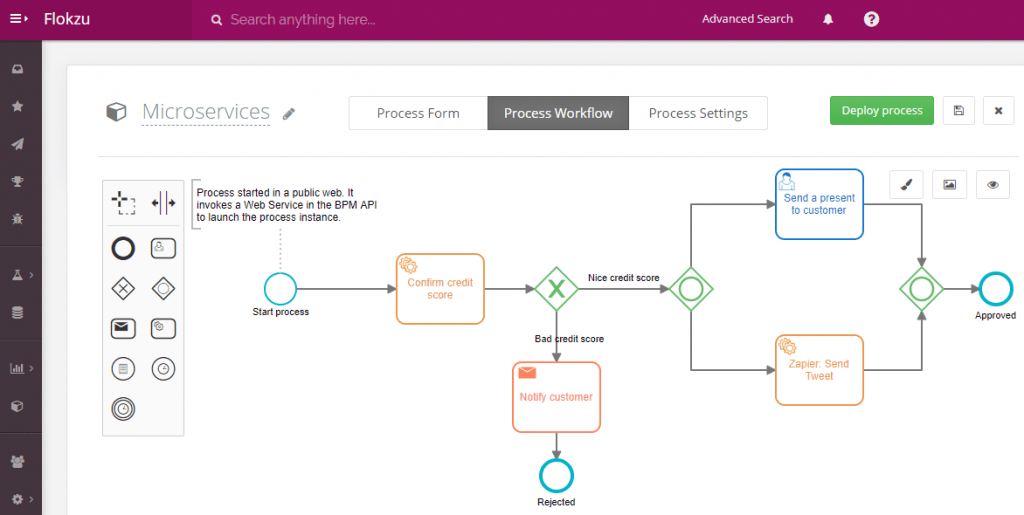Monolithic and Microservices are the two main tendencies in BPM Suites nowadays. And yes, microservices, agility, robustness, scalability… they are all cool features for a Business Process Management Suite (BPM Suite). But which of them really matter most to your organization?
There are a gradual but constant migration from Monolithic BPM Suites in large companies to much more agile cloud BPM Suites based on microservices. Why? The speed to deploy new processes and the ability to orchestrate microservices are key competitiveness factors. Especially if the organization is in a Digital Transformation journey. Let’s look at it in more detail.
Let’s first notice that there are currently two large groups of Business Process Management Systems (BPM Suites):
- the larger systems, generally provided by large software companies, which function as self-contained Suites. These “big” BPM Suites, allow to model and automate almost any process, providing a functional set and a very wide infrastructure. That characteristic of being self-contained, is what derives in calling them “Monolithic“.
- at the other extreme, are the BPM Suites that focus on covering the main functionalities for modeling and automating processes, having great integration capabilities. In other words, they take advantage of other specialized tools and integrate them into the processes. Unlike the previous ones, they are not self-contained but are “open” to integrate with other systems, whether legacy or cloud. This integration is preferably done through the orchestration of microservices.
Monolithic BPM Suites
The traditional manufacturers of BPM Suites opted for monolithic systems. These were very powerful and robust, but in return, also expensive and time-consuming to deploy new processes. The complexity of these systems lies in the fact that any extremely powerful tool is complex to use. As a result, it is very difficult in these monolithic BPMS to implement agile methodologies and continuously deliver new versions of the processes.
Another characteristic of monolithic BPM systems is that they generally have expensive license prices, as well as their subsequent maintenance. Adding this to a high cost of consultant hours specialized in such complex technologies, meant that only large organizations and corporations could access the benefits of the BPM discipline.
Microservices based BPM Suites
On the other hand, we have the new trend of modern BPM Suites, either running in the cloud or on-premise, but much more agile. These products have a smaller functional set than monolithic BPMs, but more specialized in process management. Probably they do not have all the functionalities of the others, but they counteract this lack with ample capacities of integration with other systems specialized in solving specific problems.
Usually, the integration of other systems as part of a larger business process is done through the invocation of web services. These web services are very specific, they solve the problem, have their own storage and computing capacity. They comply with an interface, which receives and returns processed data. This is why they are called microservices. To concatenate many microservices, each one solving a specific part, according to a certain logic, is called “orchestrate” those microservices. Therefore, a modern BPM suite would naturally integrate human activities (user tasks) with automatic activities through these services (service tasks).
A process example
Let’s see an example of a very simple process. The user initiates the process using a public web form, built by the website designer. This form invokes a web service using the BPM public API. Then, the BPM engine then invokes another web service to get the credit score for the customer. Based on this Web Service response, the BPM Suite rejects or moves forward using an exclusive gateway. If the customer has a nice credit score, the BPM engine launches two tasks in parallel (using an inclusive gateway). One is a User Task (a human being will perform it), to send a present to the customer. The other sends a Tweet via Zapier. Finally, when both tasks are completed, the process ends.
To sum up, this example shows the orchestration of several microservices, integrated into a business process that also includes manual user tasks.

In conclusion
Certainly, Digital Transformation initiatives align with the second paradigm (microservices orientation). That is to say that each system should specialize in something, and then integrate into a digital platform. As a result, solutions evolve simpler and quicker. For instance, you can replace a service with a newer or better provider, without affecting the behavior of the entire solution. Above all, integrating digital assets (and not reinventing the wheel) is a key enabler of digital transformation.
The truth is that in highly competitive environments, pressing on costs, there is an increasingly urgent need to react faster to changes in the market (demand and competitors). In short, the most important attribute becomes agility. Subsequently, cloud BPM Suites that support the orchestration of microservices are having a very important growth. In fact, they are replacing many large organizations monolithic BPM Suites.
Complimentary reading:
You can also schedule a work session here to model a real-life process in your organization together.



























